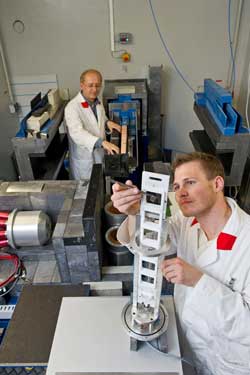Two world records at the FRM II: The world’s strongest and purest neutron beam

But that is not all: During the long maintenance break in 2011, the instrument PGAA (Prompt Gamma Activation Analysis) was improved to give it the best ratio between usable neutrons and noisy background radiation worldwide. It is now possible to determine the elementary composition of even smallest samples in the milligram range. The instrument is operated by the Universities of Cologne (Germany) and Bern (Switzerland).
Neutrons of the PGAA instrument activate the atoms of samples for which the precise composition is to be determined. The methodology is so extremely accurate that it is even possible to determine which mine delivered the ore used in a given antique coin. The PGAA generates up to 60 billion neutrons per square millimeter per second. That is an absolute world record among the scientific instruments of all research neutron sources. Other instruments produce only around half as many neutrons. “We require this high flux for small samples, for example,” explains Dr. Petra Kudejova, the responsible researcher at the PGAA. “These are samples of around one milligram.”
“We already had the highest neutrons flux, but also high levels of background radiation. That refers to radiation which derives not directly from the sample, but rather from scattered neutrons, which interfere with the measurements,” adds Dr. Zsolt Revay, also a researcher at the PGAA.
“A low level of background radiation is a prerequisite for examining small samples that react only very weakly to neutrons.” Revay and his team used the long maintenance break at the FRM II in 2011 to improve and reconfigure the shielding of the instrument in such a way that the distracting background radiation is reduced to merely one tenth of its prior value. The PGAA instrument is used primarily in the analysis of the elementary composition of objects. The measurement device can detect a single atom among one million other atoms.
This made it possible, for example, to detect tiniest traces of harmful substances captured by Technische Universitaet Muenchen Corporate Communications Center 80290 Munich, Germany www.tum.de
Dr. Ulrich Marsch Head of Corporate Communications +49 89 289 22778 marsch@zv.tum.de
Dr. Andreas Battenberg Garching Campus PR Officer +49 89 289 10510 battenberg@zv.tum.de
Andrea Voit PR-Referentin FRM II +49 89 289 12141 Andrea.voit@frm2.tum.de an air filter. A magnetic meteorite sample weighing less than one milligram was also analyzed. The results of the analysis helped classify the meteorite. In this way, a theory making a meteorite impact in North America around 13,000 years ago responsible for the extinction of the mammoths could be verified.
Contact:
Dr. Zsolt Revay, Dr. Petra Kudejova
Technische Universitaet Muenchen
Research Neutron Source Heinz Maier-Leibnitz (FRM II)
Lichtenbergstr. 1, 85748 Garching, Germany
Tel.: +49 89 289 12694 / 14765
E-Mail: zsolt.revay@frm2.tum.de, petra.kudejova@frm2.tum.de
Internet: http://tinyurl.com/88u6b58
Media Contact
More Information:
http://www.tum.deAll latest news from the category: Physics and Astronomy
This area deals with the fundamental laws and building blocks of nature and how they interact, the properties and the behavior of matter, and research into space and time and their structures.
innovations-report provides in-depth reports and articles on subjects such as astrophysics, laser technologies, nuclear, quantum, particle and solid-state physics, nanotechnologies, planetary research and findings (Mars, Venus) and developments related to the Hubble Telescope.
Newest articles

Silicon Carbide Innovation Alliance to drive industrial-scale semiconductor work
Known for its ability to withstand extreme environments and high voltages, silicon carbide (SiC) is a semiconducting material made up of silicon and carbon atoms arranged into crystals that is…

New SPECT/CT technique shows impressive biomarker identification
…offers increased access for prostate cancer patients. A novel SPECT/CT acquisition method can accurately detect radiopharmaceutical biodistribution in a convenient manner for prostate cancer patients, opening the door for more…

How 3D printers can give robots a soft touch
Soft skin coverings and touch sensors have emerged as a promising feature for robots that are both safer and more intuitive for human interaction, but they are expensive and difficult…





















